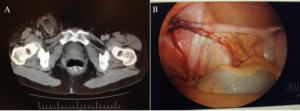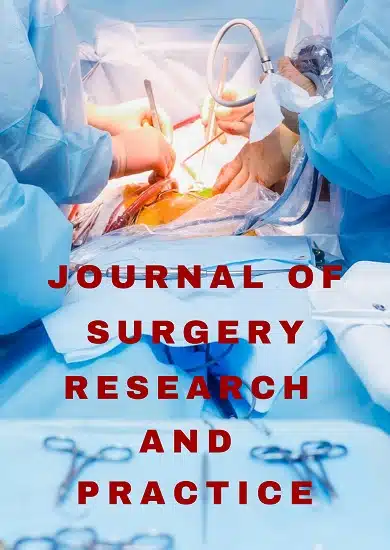Case Report | Vol. 6, Issue 1 | Journal of Surgery Research and Practice | Open Access |
Two Cases of De Garengeot Hernia: Combined Laparoscopic and Open Surgical Approach
Michelle M Dugan1*, Shruti Agarwal1, David Rubay2, Jose Yeguez1
1Department of Surgery, Florida Atlantic University Schmidt College of Medicine, Boca Raton, FL USA
2HCA Florida Lawnwood Hospital, Fort Pierce, FL USA
*Correspondence author: Michelle M Dugan, MD, Department of Surgery, Florida Atlantic University Schmidt College of Medicine, Boca Raton, FL USA; Email: [email protected]
Citation: Dugan MM, et al. Two Cases of De Garengeot Hernia: Combined Laparoscopic and Open Surgical Approach. J Surg Res Prac. 2025;6(1):1-4.
Copyright© 2025 by Dugan MM, et al. All rights reserved. This is an open access article distributed under the terms of the Creative Commons Attribution License, which permits unrestricted use, distribution, and reproduction in any medium, provided the original author and source are credited.
| Received 24 March, 2025 | Accepted 09 April, 2025 | Published 16 April, 2025 |
Abstract
A De Garengeot hernia is a rare subtype of a femoral hernia which contains the appendix. Preoperative diagnosis is challenging and most are diagnosed intraoperatively. There is currently no standard surgical approach to treatment.
We present two cases of De Garengeot hernias with perforated appendicitis, with the goal of emphasizing our surgical technique. In both cases, diagnostic laparoscopy was performed prior to laparoscopic appendectomy and subsequent open femoral hernia repair. This provided excellent visualization to fully evaluate the anatomy and pathology to determine the optimal surgical approach prior to proceeding with the repair.
After gaining experience with our two cases, we advocate for initial diagnostic laparoscopy to fully evaluate the anatomy and accurately diagnose the pathology to determine the ideal surgical approach. Laparoscopic appendectomy followed by either laparoscopic or open primary hernia repair without mesh allows for optimal visualization and infection control for a De Garengeot hernia with acute appendicitis.
Keywords: De Garengeot Hernia; Appendicitis in Femoral Hernia; Femoral Hernia Repair; Laparoscopic Hernia Repair; Combined Laparoscopic and Open; Hybrid Approach
Introduction
A De Garengeot hernia is a rare subtype of a femoral hernia which contains the appendix and accounts for 0.5-1% of all femoral hernias [1]. One theory suggests that the presence of a large and mobile cecum causes pressure on the appendix through the femoral canal [1]. This is distinguishable from an Amyand hernia, in which the appendix is contained in an inguinal hernia [2]. De Garengeot hernias are more common in women, presenting at an average age of 70 years, most commonly with a tender bulge in the groin and likely related to obesity [3]. Other risk factors include smoking, constipation and pregnancy-related changes [4]. Preoperative diagnosis is very difficult and most cases are diagnosed intraoperatively. A Computed Tomography (CT) scan can be useful in helping to identify a De Garengeot hernia, but it has been shown to have low sensitivity [3]. Due to the rarity and variability of the pathology, there is currently no standard surgical approach to treatment.
Case Report
We are presenting two cases of a De Garengeot hernia with perforated appendicitis, with the goal of emphasizing our surgical technique. In both cases, diagnostic laparoscopy was performed prior to proceeding with laparoscopic appendectomy and subsequent open femoral hernia repair. This provided excellent visualization to fully evaluate the anatomy and pathology to determine the optimal surgical approach prior to proceeding with the repair.
In the first case, a 76-year-old female with a past medical history of hypertension and a symptomatic right inguinal hernia presented to the Emergency Department (ED) with right lower quadrant abdominal pain and an acutely painful protrusion in the right groin, increasing in size. The patient was afebrile with stable vital signs and a leukocyte count of 10 K/mcL. On physical exam, a significantly tender irreducible mass was palpable in the right groin and abdominal exam was benign. CT scan revealed a 3.8 cm x 2.7 cm complex fluid collection in the right groin with the appendix protruding through the inguinal canal, suggestive of an Amyand hernia with perforated appendicitis. A diagnostic laparoscopy was performed, with findings of an incarcerated right femoral hernia containing the necrotic distal tip of the appendix and ischemic mesoappendix. Laparoscopically, the appendix was reduced from the hernia sac and an appendectomy was performed. The remaining inguinal fluid collection was opened with an oblique incision through the overlying skin. Purulent fluid was immediately evacuated and the cavity was debrided. The hernia sac was reduced and fixed to the anterior abdominal wall under direct laparoscopic visualization. The patient tolerated the procedure well and was discharged on post-operative day three. The inguinal incision healed by secondary intention with daily packing. There were no post-operative complications or recurrences after one year of follow-up care.
In the second case, a 68-year-old female with a past medical history of endometriosis and diverticulosis presented to the ED with right lower quadrant abdominal pain, nausea, vomiting and a painful protrusion in the right groin for 1 week. The patient reported a history of intermittent pain in the right groin, which was diagnosed as chronic appendicitis. She completed a course of oral antibiotics without improvement. Outpatient CT revealed findings suspicious for ruptured appendicitis within a right inguinal hernia sac (Fig. 1) and the patient was sent to the ED. She was found to have an exquisitely tender mass in the right groin with associated cellulitis and a leukocytosis of 20 K/mcL. The patient was taken to the operating room for suspected perforated appendicitis within an Amyand hernia. Diagnostic laparoscopy was performed and the patient was found to have a large incarcerated phlegmonous appendix within a right femoral hernia, which also contained an incarcerated lipoma and a small abscess. Gentle traction was placed on the cecum and the appendix was reduced from the femoral hernia (Fig. 1). Laparoscopic appendectomy was performed and the pelvis and right gutter were copiously irrigated. A drain was placed and incisions were closed. Subsequently, a 3.5 cm oblique incision was made for open exploration of the right groin. The femoral hernia lipoma was removed and the abscess was drained. The surgical site was copiously irrigated and packed with iodoform. Pathology revealed (1) severe acute gangrenous appendicitis with focal rupture and (2) right femoral hernia sac and lipoma with fibrosis and chronic inflammation. The patient was discharged on post-operative day four with a 14-day course of outpatient IV ceftriaxone. There were no post-operative complications or recurrences after three years of follow-up care.

Figure 1: CT image of the incarcerated inflamed appendix within a right femoral hernia (A); Intraoperative laparoscopic view (B).
The unusual finding of the appendix within a femoral hernia was first described by Rene Jacques Croissant de Garengeot in 1731 [5,6]. Since then, slightly over 400 cases have been reported worldwide and the incidence of appendicitis in such cases is exceedingly rare (0.08-0.13%) [6,7]. Due to the frequently atypical presentation with equivocal imaging studies, diagnosis is challenging and often delayed, with most diagnoses only made intra-operatively. Based on current literature, CT scan has proven to be the most useful pre-operative diagnostic study, although radiological differentiation of a De Garengeot hernia from other groin hernias requires a highly experienced radiologist and, in many cases, an accurate diagnosis is not able to be established by CT [5, 8-10]. Multiplanar reconstructions, coronal and sagittal, can further aid in pre-operative identification and could provide a more accurate diagnosis [9,10].
Discussion
Due to case rarity, the elusive preoperative diagnosis and variable inflammatory status of the appendix, there is no consensus on optimal surgical management. Reduction of an incarcerated or strangulated femoral hernia can be quite difficult due to the small size of the femoral hernia neck. Some techniques therefore require instrumental stretching of the orifice and opening of the inguinal or lacunar ligament, although these approaches significantly increase the possibility of recurrence and trauma to the appendix [11]. Most cases have been reported as simultaneous appendectomy with primary hernia repair, using an open anterior approach through the groin [5,6].
As proven beneficial in our two cases, we advocate for the use of initial diagnostic laparoscopy. Transabdominal Pre-Peritoneal (TAPP) method is preferred to that of Total Pre-Peritoneal Technique (TEP) as it provides better visualization and permits early diagnosis. This allows the surgeon to fully evaluate the anatomy and pathology to determine the optimal surgical approach. TAPP allows for simultaneous appendectomy and hernia sac repair with or without mesh. In several cases that started with an open inguinal approach, laparoscopic appendectomy was subsequently required due to the inability to adequately access the cecum through the inguinal incision [5,11-15]. Furthermore, by performing initial diagnostic laparoscopy and subsequent laparoscopic appendectomy, we were able to remove the infectious appendix and copiously irrigate the peritoneum prior to open exploration of the groin, which we believe reduced the risk of infection spread.
Our approach to femoral hernia repair was individualized to each patient case. In our first case, we performed primary herniorrhaphy via laparoscopic approach and in our second case we repaired primarily via the inguinal incision. Either approach is reasonable depending on the surgeon’s expertise and the anatomical pathology. It has been well documented in the literature that synthetic mesh is not recommended in the case of acute appendicitis due to the high risk of infection [16]. However, many cases have been reported which successfully reduced a normal appendix and subsequently used synthetic or biological mesh for repair to reduce recurrence rates [5,12,17].
Conclusion
In conclusion, De Garengeot hernias are exceptionally rare and often diagnosed intraoperatively, so a high degree of clinical suspicion is required for preoperative diagnosis. There are few cases and no clear consensus in the literature on the most appropriate surgical approach. After gaining experience with our two cases, we advocate for initial diagnostic laparoscopy to fully evaluate the anatomy and accurately diagnose the pathology to determine the ideal surgical approach. Laparoscopic appendectomy followed by either laparoscopic or open primary hernia repair without mesh allows for optimal visualization and infection control for a De Garengeot hernia with acute appendicitis.
Conflict of Interest
All authors declare that they have no conflicts of interest or financial ties to disclose.
Ethical Statements
This study is a case report/series of less than three patients and thus falls under “exempt” status from our institution’s Institutional Review Board. The study is exempt from patient informed consent as this was a retrospective study without reporting of any Protected Health Information or other identifiable information.
Availability of Data and Materials
Data is custodied by the author and can be released on trust.
Funding
No funding from any institution or organization.
References
- O’Connor A, Asaad P. De Garengeot’s hernia with appendicitis: A rare cause of an acutely painful groin swelling. J Surg Case Rep. 2019.
- Schaaf KA, Melnychuk EM, Ellison RD, Snover AJ. Two rare cases of appendicitis: Amyand’s hernia and De Garengeot’s hernia. Case Reports in Emergency Medicine. 2019;2019(1):6759206.
- Guenther TM, Theodorou CM, Grace NL, Rinderknecht TN, Wiedeman JE. De Garengeot hernia: A systematic review. Surgical Endoscopy. 2021;35:503-13.
- Ying L, Yahng JM. The rare case of De Garengeot hernia: Femoral hernia containing perforated appendicitis. J Surgical Case Reports. 2019;2019(11):rjz287.
- Kalles V, Mekras A, Mekras D, Papapanagiotou I, Al-Harethee W, Sotiropoulos G, et al. De Garengeot’s hernia: A comprehensive review. Hernia. 2013;17:177-82.
- Elkhawaga M, Alam AS, Eldomiaty A. Combined laparoscopic open surgical approach for De Garengeot’s hernia containing an inflamed appendix: A case report. Cureus. 2023;15(10).
- Fousekis FS, Christou PA, Gkogkos S. A case of De Garengeot’s hernia with acute appendicitis and literature review. Int J Surg Case Rep. 2018;49:55-7.
- Zissin R, Brautbar O, Shapiro-Feinberg M. CT diagnosis of acute appendicitis in a femoral hernia. Br J Radiol. 2000;73:1013-4.
- Gómez-Portilla A, Zárate C, Magrach LA. Appendix-sparing laparoscopic transabdominal preperitoneal hernioplasty for a De Garengeot’s hernia: A new case report and review of the literature. Int J Surg Case Rep. 2024;114:109207.
- Gómez-Portilla A, Merino E, López de Heredia E. De Garengeot’s hernia patients entirely treated laparoscopically: A safe and feasible alternative: A systematic review. Langenbecks Arch Surg. 2023;408:171.
- Shum J, Croome K. Management of appendicitis in a femoral hernia. Int J Surg Case Rep. 2012;3:10-11.
- Klipfel A, Venkatasamy A, Nicolai C. Surgical management of a De Garengeot’s hernia using a biologic mesh: A case report and review of literature. Int J Surg Case Rep. 2017;39:273-5.
- Bustamante Recuenco C, García-Quijada García J, Cendrero Martín M. De Garengeot’s hernia: Case report and literature review. Int J Surg Case Rep. 2019;64:58-61.
- Misiakos EP, Paspala A, Prodromidou A. De Garengeot’s Hernia: Report of a rare surgical emergency and review of the literature. Front Surg. 2018;5.
- Alkashty M, Dickinson B, Tebala GD. De Garengeot’s Hernia Treated With a Hybrid Approach: A Case Report. Ann Coloproctol. 2021;37:S55.
- Altıner S, Büyükkasap Ç, Göbüt H. Transabdominal preperitoneal hernia repair for incidental de Garengeot’s hernia. ANZ J Surg. 2022;92:2363-4.
- Cohen RB, Nerwal T, Winikoff S, Hubbard M. Minimally invasive management of de Garengeot hernia with staged robotic hernia repair. BMJ Case Rep. 2021;14:242569.
Author Info
Michelle M Dugan1*, Shruti Agarwal1, David Rubay2, Jose Yeguez1
1Department of Surgery, Florida Atlantic University Schmidt College of Medicine, Boca Raton, FL USA
2HCA Florida Lawnwood Hospital, Fort Pierce, FL USA
*Correspondence author: Michelle M Dugan, MD, Department of Surgery, Florida Atlantic University Schmidt College of Medicine, Boca Raton, FL USA; Email: [email protected]
Copyright
Michelle M Dugan1*, Shruti Agarwal1, David Rubay2, Jose Yeguez1
1Department of Surgery, Florida Atlantic University Schmidt College of Medicine, Boca Raton, FL USA
2HCA Florida Lawnwood Hospital, Fort Pierce, FL USA
*Correspondence author: Michelle M Dugan, MD, Department of Surgery, Florida Atlantic University Schmidt College of Medicine, Boca Raton, FL USA; Email: [email protected]
Copyright© 2025 by Dugan MM, et al. All rights reserved. This is an open access article distributed under the terms of the Creative Commons Attribution License, which permits unrestricted use, distribution, and reproduction in any medium, provided the original author and source are credited.
Citation
Citation: Dugan MM, et al. Two Cases of De Garengeot Hernia: Combined Laparoscopic and Open Surgical Approach. J Surg Res Prac. 2025;6(1):1-4.



